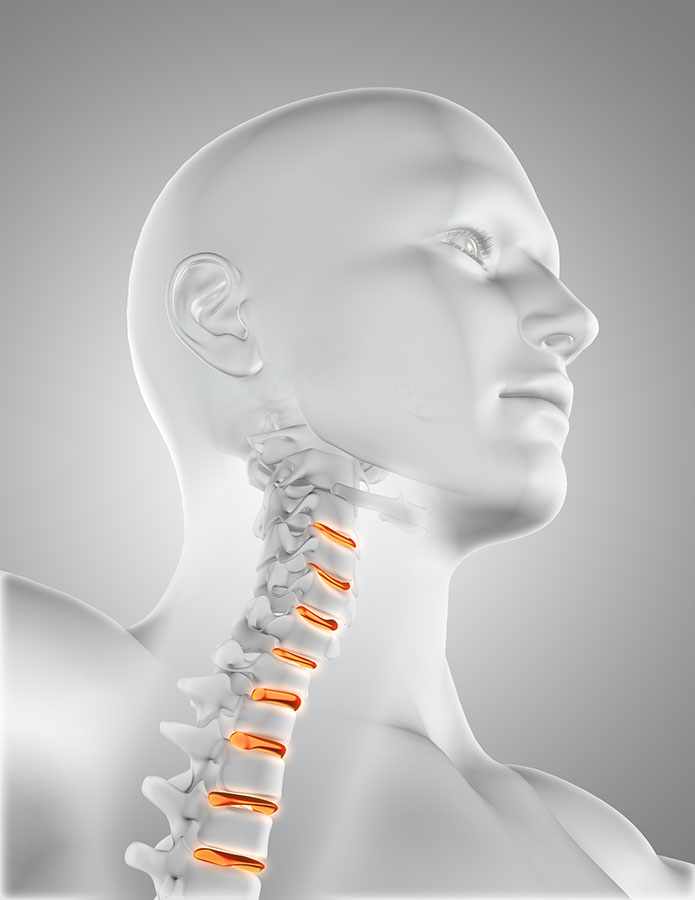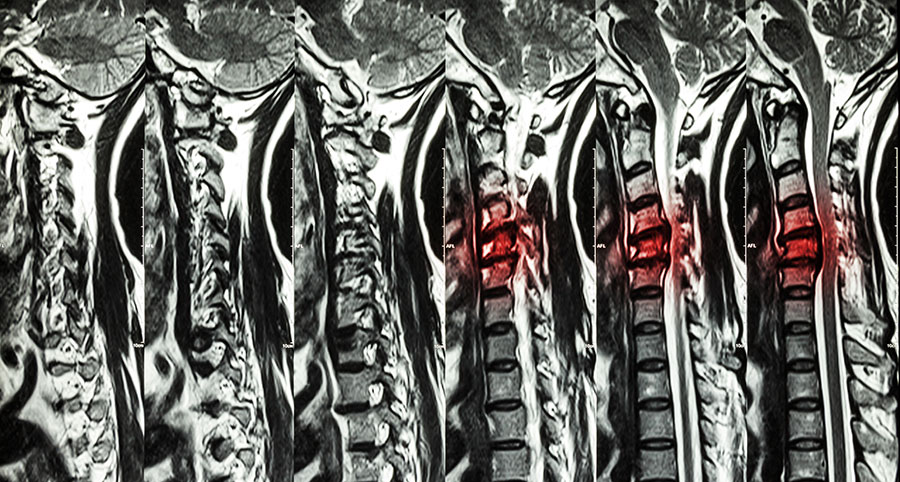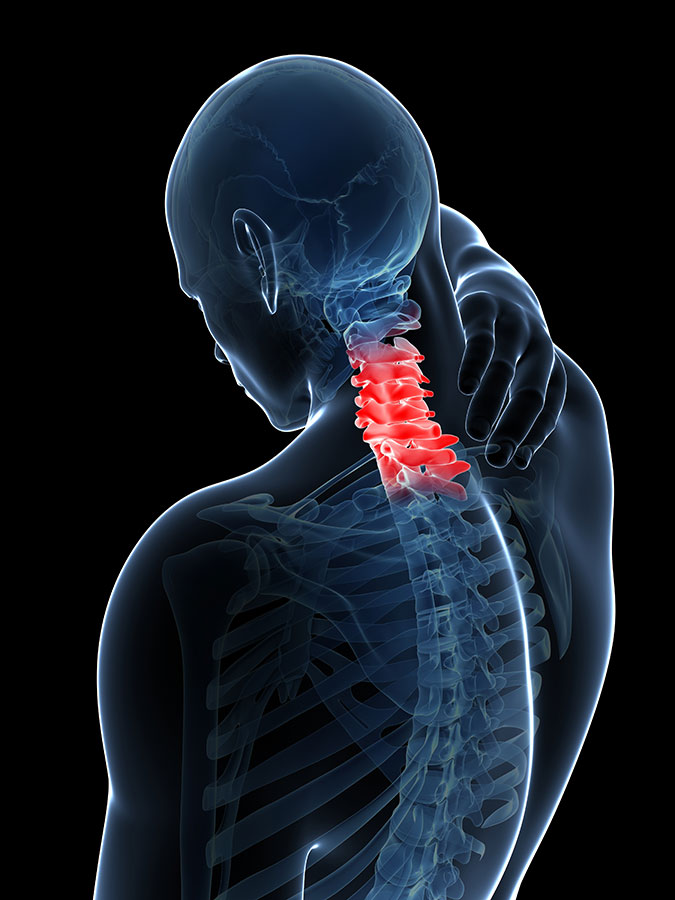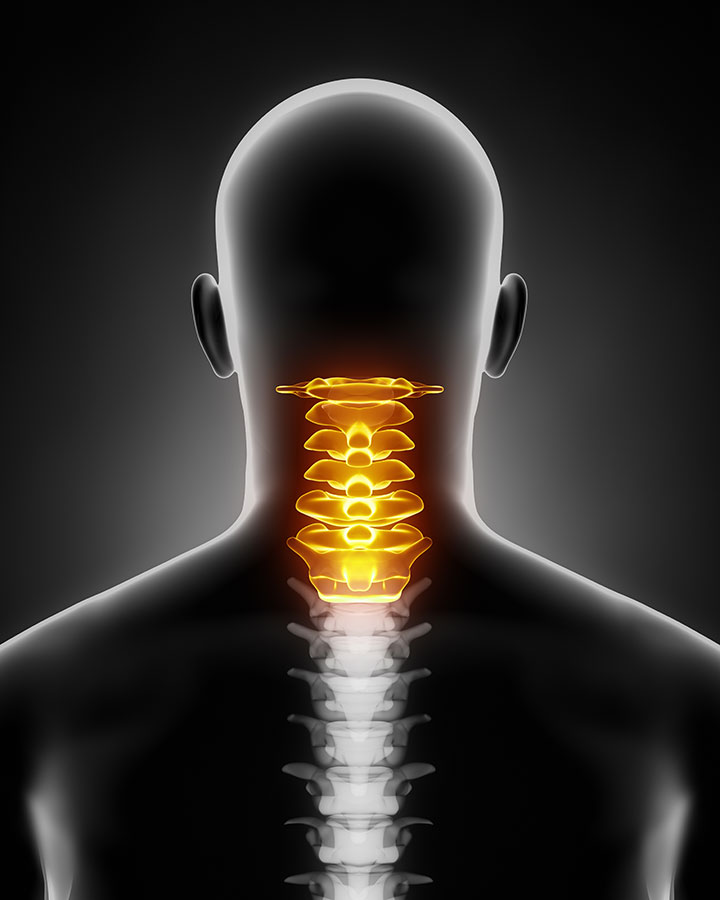Quite often a deep ache in your neck and a burning spot next to your shoulder blade are the only signs of a neck disc injury. Neck disc injuries are a common cause of neck pain, but it isn’t uncommon that this problem presents as arm or shoulder blade pain without neck pain. The pain from a chronic neck disc injury feels like a constant stiffness or discomfort which can last for days, weeks or even years.
When you have a cervical disc bulge, it compresses pain sensitive structures, like nerves. This causes a sharp, severe pain in and around your neck that settles after a couple of days, but rears its ugly head again every couple of weeks.
What are cervical discs?
Cervical discs are found in between the vertebrae in your neck. The top and bottom parts are firmly attached to the bottom of the vertebra above and top of the one below. This allows movement of our spine; otherwise we would move like like robots where your whole spine has to move all at once.
These discs have a strong outer layer of connective tissue called the annulus fibrosus. This outer layer, or shell, is responsible for keeping the soft inner core contained. The inner core is a jelly-like substance called the nucleus pulposus. This structure acts like a shock absorber, reacting to your neck movements to distribute forces going through your spine. A neck disc injury is when there is damage to these discs between the vertebrae in your neck.

What happens when you injure a disc in your neck?
A neck disc injury or cervical disc herniation happens when there is a tear in the outer shell of the disc. Depending on the degree or severity, the inner core can bulge out when the outer shell is damaged. This injury causes swelling and inflammation in the area, irritating the nerves in your neck that supply all the muscles and the skin of your arms. In some cases, this bulge of the inner core causes mechanical pressure on the nerves exiting the spinal cord at that level. That’s why you could experience pain, weakness or numbness in your arms if you have a neck disc injury.
There is usually referred pain along the level of the involved cervical nerves, running to your shoulder, arm or upper back (between or underneath your shoulder blades). This is due to swelling and inflammation which irritates the nerve, or the herniated disc putting pressure on the nerve. These symptoms can come and go over weeks, months or even years, but that doesn’t mean the problem is gone.
I have a neck disc injury – how did it happen?
The cervical discs’ outer fibrous layers can tear due to looking down repeatedly (cervical flexion movements). These layers are tightly arranged against each other. Depending on the extent of the damage to this outer layer, the nucleus pulposus can bulge out onto the spinal cord and cervical nerves, like jam squeezing out of bread.
There are different degrees of severity to the injury.
- Disc bulge – Depending on the position of your neck and pressure on it, the disc pushes outwards, damaging the outer layer. The cervical disc is still able to return to its normal position. Fleeting, sharp pain that comes and goes is the key sign as this stage.
- Disc herniation – The outer shell that should contain the inner nucleus tears. This allows the disc to push out even further.
- Disc sequestration – This happens when the disc bulge gets pinching off and detaches, causing a ‘loose fragment’ of the disc next to the spinal nerves or spinal column. At this stage it’s unable to return to it’s original position.
Causes of neck disc injuries
- Sleeping in an awkward position
- Sudden, forceful bending your neck
- Whiplash injuries
- Repetitive strain like keeping the neck in a sustained position for long periods of time
- Poor posture
- Disc degeneration
How severe is my injury?
Acute neck disc injuries have a sudden onset e.g. waking up with neck/arm pain, after a car accident etc. At first, the pain is severe and constant. Patients often feel that they just have severe muscle spasm, because they have searing arm pain without any neck pain. You could also feel pins and needles down the arm and means there is nerve irritation at the level of the neck. If this is the case, there isn’t necessarily pressure on the nerve, but the swelling and inflammation irritates the nerve where it exits the spinal cord.
If there is pressure on the nerve, or a “pinched nerve“, you will have numbness in the arm and, in worse cases, loss of strength. The pressure is caused by a disc prolapse or sequestration. This means your arm will feel weak, and you may notice that you have trouble lifting the arm or that your hands feel clumsy. If you have these symptoms with severe pain in the arm you should call us as soon as possible as it can lead to permanent nerve damage.

Diagnosis
Physiotherapy diagnosis
Physiotherapists are able to accurately determine the severity and level the disc is bulging or prolapsed. We assess your neck with specific tests and palpation. If you experience arm pain we test your shoulder by stressing the muscles and joints to determine the exact cause of your pain. In doing so, we can eliminate your shoulder as a contributing factor and focus on the main cause of the problem.
We also do a neurological assessment to establish the extent of the nerve involvement that could be caused by a pinched nerve in your neck. This enables us to determine which disc and nerve level/s in your neck are involved. Physiotherapists are first line practitioners, so we are more than capable of dealing with a slipped disc in your neck, and will refer you if you need further imaging, medication or surgery.
X-rays
X-rays are not useful with neck disc injuries as only your bones show up on X-rays. It may however give us an indication of disc degeneration or other conditions. In the case of trauma, X-rays are important to rule out any fractures.
CT scan
A CT scan may be useful to identify the slipped disc in your neck, but it’s difficult to identify the nerve roots and its close relationship with the disc putting pressure on these nerves. If you suspect a slipped disc in your neck, especially if you’re feeling nerve pain, an MRI will prove to be much more valuable than CT scans. A physiotherapist cannot refer you for these scans, but we can refer you to the right specialist if necessary.
MRI
An MRI is the best way to visualize herniated discs in your neck. This would be the investigation of choice, but usually isn’t necessary to make a diagnosis. Physiotherapists use clinical tests to get to the root of the problem, but can also refer you to the right specialists for further imaging if necessary.
Why is the pain not going away?
Neck disc herniations do heal, but patients usually have repeated episodes of pain and stiffness over time. We aim to find the cause of the problem and activities that will make the pain come back again. During treatment we will teach you how to take care of your neck to prevent further episodes of pain.
If you have a herniated disc in your neck, this means it’s 25% or less the size of the main jelly-like nucleus. You will have mild symptoms, but if you don’t attend to the injury it gets worse. Over time, you’ll wake up with arm pain more often, it takes longer to resolve every time, until it eventually doesn’t go away anymore. The repeated episodes of pain and stiffness also cause muscle wasting and chronic nerve irritation in the area, leading to a vicious cycle of pain and muscle spasm.
If a disc herniation gets worse you will have a disc sequestration. This means that the part of the nucleus that bulged actually separates from the main part in the disc. The result is a “loose fragment” that puts pressure on nerves, or in more severe cases, the spinal cord. Our physiotherapist do a physical assessment to determine where and to which extent the neck disc is putting pressure on your nerves.
Problems we see when patients come to us with neck pain
Most patients presenting with a cervical disc herniation complain of arm pain, rather than actual neck symptoms. The patients are more concerned about the pain in their upper back, shoulder and arm. We tend to find that general practitioners refer the patient to us due to “severe neck spasms” or sending them for a sonar of the shoulder (which turns out to be perfectly normal). Only when we start investigating the neck area, we reproduce your shoulder and arm pain. This just shows that the root of the problem is in your neck and not your shoulder or arm. Treating your arm or shoulder may sometimes give temporary relief, due to overflow to your neck, but without treating your neck – your pain will not subside.
Another problem we see with neck disc injuries is that people either do not seek help at all or they do not complete rehabilitation. If the problem worsens over time they end up having surgery, adding more scarring to an already injured area. The end result is neck stiffness and a longer rehabilitation period.
One of the most common problems we encounter that slows the healing process is the time it takes for patients to seek treatment. In many cases patients think that they are experiencing neck muscle spasm, they dose themselves with muscle relaxants and anti-inflammatory medications. Medication will only mask the problem, but when the medication wears off the pain will return.
Some patients buy soft collars at the pharmacy to help with pain relief. These can give you temporary relief by taking load off the muscles, but what we see is that people start to depend on this “support”. The muscles around the neck get weaker the longer you use the collar and the neck will get more stiff because it’s not moving. The neck discs need movement to stay healthy, so prolonged use of a collar will have a negative effect on healing.
The same principle applies to slings for the arm pain. However, an arm sling will not provide much relief, because the pain isn’t caused by the shoulder. A sling will cause the muscles around the shoulder to become weak and it encourages the wrong position of the shoulder.
Physiotherapy treatment
At first physiotherapy involves education and techniques for pain relief.
- Soft tissue mobilization, including myofascial release
- Electrotherapy, like laser and ultrasound
- Strapping and taping
- Cervical joint mobilizations are very effective for pain relief
- Traction is an old-school technique yet still very effective for treating cervical discs
- Dry needling is used to stimulate the healing process within your body and to localize a cellular response
- As soon as pain allows we will start with gentle exercises to strengthen the neck muscles
- We will guide you through this process. If necessary we can refer you for imaging or to a specialist.
Treatment will include identifying contributing factors aggravating the pain or causing recurrence of the injury. This may be sleeping position, workstation setup putting strain on the neck, muscle imbalances which may lead muscle spasm as some muscles work “harder” to compensate or stiffness of the neck which may put even more strain on an already injured disc.

Phases of rehabilitation
1st Phase: Protect the injured tissue (Week 0 – 1)
Avoid activities that aggravate your symptoms like looking down for prolonged periods of time or looking over your shoulder. A soft collar may be useful for 2 or 3 days during this phase. Do not train during this phase and also avoid picking up heavy objects. The nervous system is already irritated due to the injury and picking up heavy objects creates more tension in the nerves going down the arm.
2nd Phase: Regain range of movement (week 1-2)
The first aim of treatment will be to restore normal, pain free movements of the neck. We use massage, joint mobilization, neural mobilization techniques and isometric exercises (without movement) during this phase. Exercises to activate the deep stabilizing muscles of the neck are especially important during this phase.
After this phase of rehabilitation you should have a significant decrease in symptoms and be able to complete most daily activities with minimal pain. Once you have full movement of the neck you will progress to the neck phase of rehabilitation.
3rd Phase: Muscle activation and motor control (Week 2 -4)
After the range of movement of the neck has been restored the next phase of rehabilitation will involve strengthening the muscles around the neck. This part or treatment is important to improve stability of the neck and prevent re-injury. Initial strengthening will be without resistance. As muscle strength and pain improve resistance bands will be added for further strengthening.
At the end of this phase of rehabilitation you should be able to complete daily activities without pain and be able to start light weight-training or jogging. Once you have sufficient muscle strength through the whole range of movement of the neck you will progress to the next phase of rehabilitation.
4th Phase: All about neurodynamics (week 4-6)
All the nerves in the body are connected to form one big system – from the brain to fingertips and toes. When you have a slipped disc in your neck, the swelling, inflammation and scarring affects the way nerves move in the body (neurodynamics). This causes nerve symptoms in your arm like pins and needles or numbness.
During this phase of rehabilitation we will add specific exercises to restore neurodynamics. You will do specific exercises to restore the normal movement of the nerves and exercises aimed at restoring the nerves’ ability to handle tension.
At the end of this phase you should be able to do stretches through full range of motion without experiencing pins and needles in your arms.
5th Phase: Stability and strength (week 6+)
A kinetic chain is a concept that proposes that different parts of the body are connected via joints, therefore movement or dysfunction in one area affects other connected areas. The neck connects the head to the upper back and shoulders and all these areas function as a unit. Improving muscle strength in the upper back and shoulders can decrease load and stress on the neck. The reverse is also true, if there is weakness in a part of this chain it places extra stress on other areas. Every part of the kinetic chain should play its part in movement to return to optimal functioning.
This phase of rehabilitation will add exercises to strengthen muscles around the shoulder blades while continuing with strength and endurance training of the neck muscles. Kinetic chain exercises i.e. exercises involving the neck, shoulders and upper back, will be added for example throwing, push-ups etc. to prepare you for return to sport. More complex, full body exercises may also be added late in this phase e.g. burpees.
At the end of this phase of rehabilitation you should be able to train and exercise without pain, stiffness or discomfort.
Healing time
The faster we can attend to a herniated disc in the neck, the shorter the healing time. Firstly, we will treat the swelling and inflammation in the area and this process can take between 3 days and 2 weeks. Pain can take 6-8 weeks to go away completely, even though the initial severe pain will gradually subside within the first 2 weeks.
Your intense pain will improve and be replaced by stiffness. As the healing process continues, you will feel more stiffness, rather than pain. However, the torn outer layers of connective tissue may not be fully healed when pain subsides, so it is very important to complete our rehabilitation program.
The disc is especially vulnerable to re-injury during the first 6 weeks. Repeated episodes of injury to the disc leads to disc degeneration as the disc loses some of its height, which in turn could lead to more compression which ends up putting pressure on nerves.
Other forms of treatment
- Chiropractic treatment claims to be an effective treatment for a slipped neck disc. However, strong techniques and adjustments may aggravate the condition or cause re-injury of the disc.
- Pain medication provided by a general practitioner can be a very effective adjunct to therapy. This provides us with a window period in order for us to treat the slipped disc.
- Medication may include muscle relaxants and anti-inflammatories. This could be useful in the initial phase of healing along with physiotherapy. The problem with muscle relaxants is that it doesn’t only work on muscle spasm, it also affects the small muscles around the spine responsible for stability. These are precisely the muscles we will start to activate and strengthen during the first phase of rehabilitation.
- A cortisone injection will improve the swelling and inflammation, but the injury still needs time to heal. Physiotherapy supports the natural course of healing.
- Soft collars/cervical braces may be useful in the first 2-3 days after the injury for pain relief, but prolonged use will result in weakness of the muscles around the neck. These braces often also encourage incorrect posture of the neck.
- Biokineticists can help with final stage rehabilitation and return to sport once pain and stiffness are no longer present.
Is surgery an option?
In some patients multiple levels may be affected with one or more disc bulges or severe degenerative changes in addition to their bulging disc(s). If the nerve symptoms get worse i.e. pins & needles becomes numbness then loss of strength in the arm, surgery may be an option. Worsening nerve symptoms indicate pressure on the nerves and surgery becomes necessary to prevent permanent nerve damage.
If non-surgical treatment fails, the surgical options include cervical discectomy. This involves surgical removal of a part or all of the intervertebral disc and is usually followed by spinal fusion to fuse the vertebrae. Another option may be artificial disc replacement, but the surgeon will follow specific criteria to determine if a patient is a candidate for this intervention.
What else could it be?
- Neck Joint Degeneration (Cervical Spondylosis)
- Neck muscle spasm,
- Cervical Disc injury (Slipped neck disc)
- Interspinous ligament sprain
- Pinched nerve in the neck
- Cervical Facet joint sprain
- Neck pain coming from other areas
Also known as
- Neck disc injury
- Cervical disc hernia
- Neck slipped disc
- Cervical disc bulge
- Bulging disc
- Prolapsed disc
- Herniated disc
- Discogenic Wry Neck
- Intervertebral Disc Injury
- Sprained Disc


